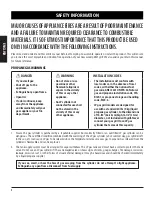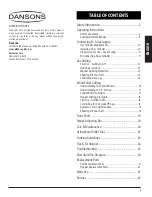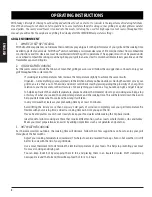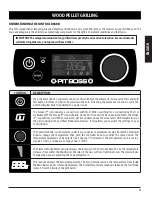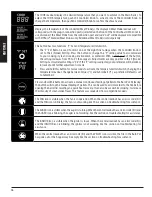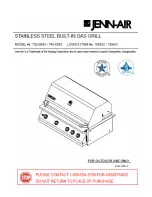
ENGLISH
3
3. Do not connect or disconnect the gas cylinder while the unit is in use or is still hot. When the grill is not in use, ensure
regulator knob is turned to OFF and disconnect the gas cylinder. Never move or transport the unit while the gas cylinder is
attached. Do not store a spare LP gas cylinder under or near the appliance.
4. Cylinders must be stored outdoors out of reach of children and must not be stored in a building, garage, or any other
enclosure area.
5. Always check for gas leaks when you connect and disconnect the regulator to the gas cylinder, especially after a period of
storage (for example, over winter). Check all connections for leaks with a soapy water solution and brush. Never use an open
flame to check for leaks.
6. This outdoor grill is not intended for installation in/on recreation vehicles or boats.
Never use this appliance in an enclosed space, such as a camper, tent, car, boat or home. This appliance is
not intended for and should never be used as a heater.
7. Do not obstruct the flow of combustion and ventilation air to this appliance. Keep the burner tube and portholes clean and
free from debris. Clean before use. Regular care and maintenance is required to prolong the lifespan of your unit.
8. Clean and inspect the gas regulator before each use of the outdoor cooking gas appliance. Replace the gas regulator prior
to being used if there is evidence of excessive abrasion or wear. Use only the gas regulator assembly that has been supplied
with this gas grill. Do not use a regulator from another manufacturer.
Do not use lava rock, wood chunks, charcoal, lighter fluid, alcohol or other similar chemicals for lighting or
relighting. Keep all such substances and liquids well away from appliance when in use.
9. Operate this appliance using liquefied petroleum only, which is also specified on the rating label on the unit. Do not attempt
to operate your grill on other gases. Do not attempt to convert this LP unit to natural gas. Failure to follow this warning could
lead to fire, bodily harm, and will void your warranty.
10. The location of the burner tube with respect to the orifice is vital for safe operation. Check to ensure the orifice is inside the
burner tube before using the gas grill. If the burner tube does not fit over the valve orifice, lighting the burner may cause
explosion and/or fire.
11. The liquefied petroleum (LP) cylinder must be constructed and marked in accordance with the specifications for LP Gas
Cylinders of the U.S. Department of Transportation (D.O.T.) or the National Standard of Canada, CAN/CSA-B339, Cylinders,
Spheres and Tubes for Transportation of Dangerous Goods; and Commission. Gas cylinder must also be provided with a listed
overfilling prevention device.
12. The LP gas tank must have a shutoff valve, terminating in an LP gas supply tank valve outlet, that is compatible with a Type
1 tank connection device. The LP gas tank must also have a safety relief device that has a direct connection with the vapor
space of the tank.
DANGERS AND WARNINGS
You must contact your local home association, building or fire officials, or authority having jurisdiction,
to obtain the necessary permits, mission or information on any installation restrictions, such as any grill
being installed on a combustible surface, inspection requirements or even ability to use, in your area.
1. A minimum clearance of 914 mm (36 inches) from combustible constructions to the sides of the grill, and 914 mm (36 inches)
from the back of the grill to combustible constructions must be maintained.
Do not install appliance on combustible
floors, or floors protected with combustible surfaces unless proper permits and permissions are obtained by
authorities having jurisdiction.
Do not use this appliance indoors or in an enclosed, unventilated area. This wood pellet
appliance must not be placed under overhead combustible ceiling or overhang. Keep your grill in an area clear and free from
combustible materials, gasoline and other flammable vapors and liquids.


